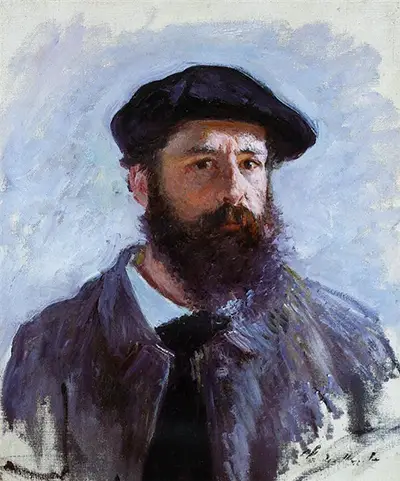One of several self-portraits he executed, this oil on canvas portrait was painted while living in Giverny, France, where Monet moved with his second wife in 1883; it measures 56 x 46 cm and is currently housed within a private collection.
Monet depicts himself wearing a black beret and a grey coat over a white shirt, against a predominantly blue background. His gaze is slightly off centre, not quite meeting the viewer's eye. The left side of his face and forehead is highlighted and there is a distinct twinkle in his eyes, despite the serious expression represented by a slightly furrowed brow.
Fervent strokes of numerous colours represent the creased fabric of the overcoat. Much smaller brushstrokes are used to depict his textured beard, which one can almost imagine reaching out and touching.
Self Portraits have offered us an insight into the personalities of all manner of famous artists over the centuries, most notably the likes of Vincent van Gogh, Michelangelo, Leonardo da Vinci, Rembrandt and Albrecht Durer.
This painting is considered an Impressionist style of art, wherein the perceptions of the subject are conveyed by the artist, rather than the painting being a specific and accurate likeness. Often described as the 'driving force behind Impressionism', Monet's paintings were always characterised by an exquisite appreciation of light and colour.
He carefully depicted where light fell on the subject, contrasted with deep shadows. This particular effect was thought to be inspired by the Japanese tradition of using wood block prints.
Monet painted loosely and vigorously with short fast brushstrokes to build up a patchwork of bold colours, working the whole canvas at once. Each stroke was effectively a snapshot of his visual impression at that time, the process of painting reflecting a continual improvisation from start to finish.
Careful layering of colour was administered, sometimes using scumble (application of a thin layer of paint to subdue the effects of a previous application) with meticulous juxtaposition of warm and cool colours to intensify the sense of distance.
It is also known that Monet suffered from cataracts, so it has been postulated that his soft and blurred images may simply be how he saw the world, rather than deliberately impressionistic, however his style remained much the same even after their removal.
Unlike previous artists, Monet favoured the use of lighter colours as the base for his paintings, rather than the darker primers that were the traditional choice of the time (it is known that he often spent money on paint rather than food!). He used commercially available paint, selecting darker paints specifically to make the lighter colours appear brighter.
He particularly enjoyed experimenting with colour and was fascinated by how things looked at different times of day with the changing light. His portraits not only portrayed figures but also beautifully captured the atmosphere.


